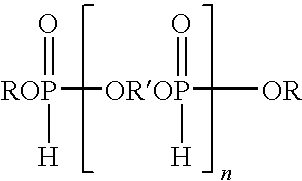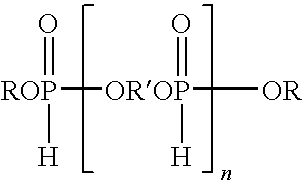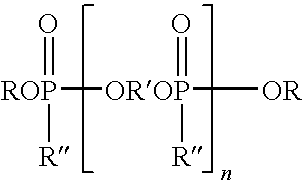Oligomeric phosphonate compositions, their preparation and uses
a technology of oligomeric phosphonate and composition, which is applied in the field of preparation and use of oligomeric phosphonate composition, can solve the problems of long reaction time and achieve the effect of low viscosity
- Summary
- Abstract
- Description
- Claims
- Application Information
AI Technical Summary
Benefits of technology
Problems solved by technology
Method used
Image
Examples
example 1
[0051]A reactor, assembled for distillation, was charged with dimethyl phosphite (457.9 g, 4.16 mol), diethylene glycol (275.95 g, 2.6 mol), 1,4-cyclohexanedimethanol (150 g, 1.04 mol) and a catalytic amount of sodium methoxide (2.25 g, 25 wt % solution in MeOH). The mixture was stirred and heated under a nitrogen atmosphere in the reactor at ±80 to 130° C. to distill the methanol generated in the reaction. The temperature was gradually raised until no more methanol distilled (≦130° C.). The reaction was driven as far as possible by continuing to heat the mixture (≦100° C.) while gradually decreasing the pressure. The product of this reaction was an oligomeric hydrogen phosphonate. About 233 grams of methanol, the theoretical amount, were collected.
[0052]The distillation head was replaced with a reflux condenser, and then methyl acrylate (358 g, 4.16 mol) was added to the oligomeric hydrogen phosphonate in the reactor. The mixture was heated to a temperature of 80° C. and sodium met...
example 2
[0053]The procedure of Example 1 was repeated except that the dimethyl phosphite, diethylene glycol, and 1,4-cyclohexanedimethanol were used in a mole ratio of 5:3:1, respectively, to form the intermediate product which was then reacted with methyl acrylate in the same manner as described in Example 1. Overall conversion for the two steps was approximately 85%. The final oligomeric product contained ˜12.4% phosphorus, as determined by ICP.
example 3
[0054]The procedure of Example 1 was repeated except that the dimethyl phosphite, diethylene glycol, and 1,4-cyclohexanedimethanol were used in a mole ratio of 7:4:2, respectively, to form the intermediate product which was then reacted with methyl acrylate in the same manner as described in Example 1.
PUM
| Property | Measurement | Unit |
|---|---|---|
| temperature | aaaaa | aaaaa |
| temperature | aaaaa | aaaaa |
| temperature | aaaaa | aaaaa |
Abstract
Description
Claims
Application Information
 Login to View More
Login to View More - R&D
- Intellectual Property
- Life Sciences
- Materials
- Tech Scout
- Unparalleled Data Quality
- Higher Quality Content
- 60% Fewer Hallucinations
Browse by: Latest US Patents, China's latest patents, Technical Efficacy Thesaurus, Application Domain, Technology Topic, Popular Technical Reports.
© 2025 PatSnap. All rights reserved.Legal|Privacy policy|Modern Slavery Act Transparency Statement|Sitemap|About US| Contact US: help@patsnap.com



